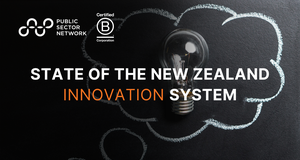At a recent Data Management & Analytics NZ Virtual Event, we had our expert panel discuss strategies on how to Implement Holistic Data Governance for Transparency, Ethics, and Public Benefit

Jan Sheppard,
Chief Data & Analytics Officer,
Institute of Environmental Science Research (ESR)

Alistair Vickers,
Chief Information Officer,
Tu Ora Compass Health

Rogan Clarke,
Director, Digital Change,
Inland Revenue Department
Across many industries these days, it is often said that data is the lifeblood of society, and this became, even more, the case during the pandemic. Data helps government agencies to better serve their citizens, which was definitely the case during the height of various COVID-19 strains, but it is also data that makes our smartphones ‘smart’ and allows us to order products online. Yet even within all that, the people who work with data regularly question what it is, and therefore aren’t always sure how to create governance strategies around it, and how it uses it in a holistic way.
Three leading experts from different industries across New Zealand have come together to discuss these and other topics, and in the process have painted a somewhat bleak picture about how data is governed these days, but have also shed some light on opportunities and future planning. Together, they have provided a unique perspective on data in 2022 from a government perspective, and have given all of us some things to think about when we share our data or interact with government services.
Defining ‘data’ and creating appropriate governance strategies
In the first instance, Alistair Vickers , the Chief Information Officer at Tu Ora Compass Health, which is a primary care network social enterprise, says that “the younger generations have a very different idea as to what data is compared to the older generations.” Jan Sheppard , the Chief Data & Analytics Officer at the Institute of Environmental Science Research, known colloquially as ESR and the country’s primary research institute specialising in sciences, agrees and says that this “generational definition” plays out in very interesting ways. Traditionally, data was seen “as the answer to all our problems, or the root cause of all our issues.” It played out in things like “names, birthdates, account numbers and those sorts of things,” but at the mention of the word ‘data’ these days, the younger generation sees “images, locations, and points in time.” Putting these two together, data also involves emerging technologies like facial recognition and even artificial intelligence.
“Because of the transformations that technology has enabled, it is really hard to come up with a single strategy or even a single definition for dealing with data… If we stay stuck in the attributes, labels, and numbers when it comes to data, then we’re not actually operating in the world where people exist.”
says Jan Sheppard, Chief Data & Analytics Officer, Institute of Environmental Science Research (ESR)
When it comes to data therefore, the important thing is to be agile, both in its use and meaning. For governments, this is a challenge and it means “shifting our definition and governance strategies to embrace the opportunities that technologies have given us.”
In relation to governance strategies, Rogan Clarke , the Director of Digital Change at the Inland Revenue Department, says that as a society, “we have become very data hungry,” but the fact that data comes in many different formats means “this hungriness is driven by a risk aversion and a lack of collaboration across agencies.” This is a problem for governments because they are supposed to be the “efficient custodians of data,” but at the moment “we are not really executing very well on that efficiency.” Much of the governance around data is usually focused on privacy, but that alone “leads to a lot of friction in the system,” as well as inefficiency and “a great burden on customers.” Whilst government often operates in vertical siloes, as we’ve seen, “customers live in a world which is horizontal with cross-agency cooperation. They expect us to do the same.” From a customer’s perspective, once they submit something to the government, they accept that the government now has that information, but “when we ask for it multiple times, they see us as living on disparate data islands.”
“The nature of governance at the moment doesn’t allow us to be citizen-centric and to have data-centric service provision, which is what customers expect and how they operate… The challenge for us is to break down the barriers whilst ensuring that the sovereignty and security of the data are preserved.”
says Rogan Clarke, Director, Digital Change, Inland Revenue Department
Jan Sheppard, Chief Data & Analytics Officer, Institute of Environmental Science Research (ESR)
Treating data as a treasure
To really have good data governance it is critically important to treat the data that has been entrusted to the government “with respect, and to acknowledge the cost that was associated with the giving of that data.” Jan Sheppard says that one way to look at data is not as a resource or as information, but rather “as a treasure. For us in government, in many ways, it is a gift from the past to the future.” Previously, data was used to simply provide statistics and clarity to certain situations and programs. It may have been important, but it was still largely “grey and dreary. Data should add colour to our world, and it should be used to create citizen-centric views so that we can better deliver services as a result.”
In that sense, governance is important because it keeps the data “safe and relevant.” It can then be used to “understand the future and to inform insights so that actions can be taken.” It can even help in stopping things from “becoming weaponised.” Largely because of the possible negative ramifications, “we as a government have become scared of data, but as such we are missing out on the potential that this rich resource can give us.” Alistair Vickers adds that this treasure needs to be protected and “we need to make it accessible in the right ways to actually derive insights.”
Looking at data in a new way
Another way to look at data, especially in a New Zealand context, is through a Maori perspective. Jan Sheppard says that the Maori view generally favours the collective over the individual. “So if we take a more holistic view then we see that the only reason data is entrusted to us and the only reason that we exist as a public sector is to create a benefit for the public.” Of course individuals within the system are important and that the data they entrust is a necessary resource, but for the benefit of all, “we need to work together and across agencies and open up our opportunities as a collective for a greater future.”
Despite this holistic and collaborative view, however, people are the reason why the data exists in the first place and Rogan Clarke says that “the grand frameworks are important,” but from an individual perspective, “there’s a micro governance that occurs as well in terms of myself as a citizen deciding to share my data.” At the end of the day, it comes down to trust and “how much do citizens trust us.” In order to build up that trust, “we need to step out of this patriarchal position of the government, where we decide who the trusted parties are, and instead allow customers themselves to decide who they trust.” Of course, there are security and consent permissions as well, but “if it is clearly articulated then it will become more manageable over time.” Ultimately, “we need to change the paradigm of data access and sharing across government.” In line with Maori principles, “it is about putting the customer at the top of the pyramid, but looking at things holistically as well.”
Alistair Vickers says that in many ways, a lot of these principles are currently being implemented “with primary care data.” Previously, medical data came from GPs or hospitals, and rarely was there any interaction between the two, or any connection with data that came from different sources even if it was about the same patient. Now the sector is looking at “regional data warehousing, where we can do far better population health analysis. We can also identify ways to improve, and maybe pick up some systemic health issues.” It is really about “focussing on health equity.” Having a data warehouse and essentially a ‘single source of truth’ can be “better managed and far more secure.”
“Having data managed centrally and thinking about data in new ways is really about helping people make better, more informed decisions about their own lives.”
says Alistair Vickers, Chief Information Officer, Tu Ora Compass Health
Looking to the future
Rogan Clarke would like to take the data warehousing model one step further. “There’s perhaps some merit in exploring a more federated data model.” In NSW and in countries like Estonia, “they have an ‘ask citizens once’ approach, and once the government has some information from citizens, they can’t ask for it again. This may work for us and for data too. It not only adds to data equality but it also provides greater efficiency.” The only problem potentially is that it may not work for people who are “on the wrong side of the digital divide.” At the same time, this kind of model they only need to interact with the government once, “so it might be a solution that works for them and gives them power.”
Jan Sheppard says that though the country may not yet be ready for a federated system, the example of the pandemic has “highlighted what can happen when we do share data and what we can achieve as a country like we never have before.” In terms of data, the lesson however was that “we weren’t prepared and we weren’t joining up our data.” In truth, there were enough signs, from bird flu and swine flu to scientific predictions about an upcoming epidemic, but globally, no one really paid attention to those signals. However, COVID-19 has shown “how important it is to join up our data and look to the future.” What this really shows is that “we need to be investing in the future more, and we need to use things like modelling from across the various sectors and across the public sector.” Not only can such modelling predict future catastrophes, but it can also help with current crises like “housing, health and those who are slipping through the gaps. If we can’t do this for a better future, then we as a public sector will fail.” The pandemic has shown the world and the various public sectors that “there is a big reason to move past our current approaches to governance and our siloed nature around data.” This is not to say there won’t be challenges, “but if we step forward together, then we’ll make some good progress.”




















